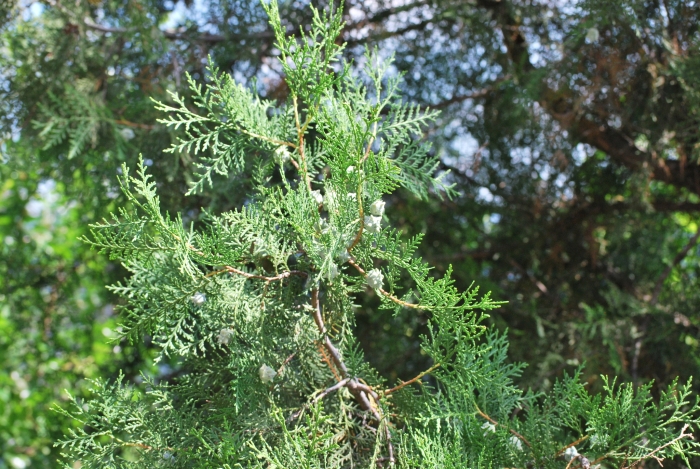Oriental Arborvitae
(Platycladus orientalis)
Oriental Arborvitae (Platycladus orientalis)
/
/

Andy Kleinhesselink
Public Domain
Image By:
Andy Kleinhesselink
Recorded By:
Copyright:
Public Domain
Copyright Notice:
Photo by: Andy Kleinhesselink | License Type: Public Domain | License URL: http://creativecommons.org/publicdomain/zero/1.0/ | Rights Holder: Andy Kleinhesselink | Publisher: iNaturalist | Date Created: 2018-08-24T13:45:53-07:00 |



















































Estimated Native Range
Summary
Platycladus orientalis, commonly known as Oriental Arborvitae, is an evergreen tree or shrub native to the open woodlands and forest edges of East Asia, particularly in China and Korea. It is a monoecious species, meaning it has both male and female reproductive parts on the same plant. Oriental Arborvitae is small and slow-growing, typically reaching heights of 15–20 meters (49–66 feet) with a trunk diameter up to 0.5 meters (1 foot 8 inches). The foliage forms in flat sprays with scale-like leaves that are 2–4 mm (0.08–0.16 inches) long. The leaves are bright green but may turn a brownish or coppery orange in the winter, adding seasonal interest.
Oriental Arborvitae is valued for its compact form and attractive foliage, making it a popular choice for hedges, screens, and topiary in parks, gardens, and home yards. It is also used in cemeteries for its solemn and formal appearance. This species is adaptable to a range of soil types, from fast to slow-draining, and prefers full sun to part shade. While it requires medium amounts of water, it is relatively drought-tolerant once established. Oriental Arborvitae is resistant to most pests and diseases but can be susceptible to root rot if planted in poorly drained soils. It is also tolerant of urban pollution, making it suitable for urban planting.CC BY-SA 4.0
Oriental Arborvitae is valued for its compact form and attractive foliage, making it a popular choice for hedges, screens, and topiary in parks, gardens, and home yards. It is also used in cemeteries for its solemn and formal appearance. This species is adaptable to a range of soil types, from fast to slow-draining, and prefers full sun to part shade. While it requires medium amounts of water, it is relatively drought-tolerant once established. Oriental Arborvitae is resistant to most pests and diseases but can be susceptible to root rot if planted in poorly drained soils. It is also tolerant of urban pollution, making it suitable for urban planting.CC BY-SA 4.0
Plant Description
- Plant Type: Tree, Shrub
- Height: 20-40 feet
- Width: 10-15 feet
- Growth Rate: Rapid
- Flower Color: N/A
- Flowering Season: Non-Flowering
- Leaf Retention: Evergreen
Growth Requirements
- Sun: Full Sun, Part Shade
- Water: Medium
- Drainage: Fast, Medium, Slow
Common Uses
Bird Garden, Border Plant, Drought Tolerant, Hedges, Rock Garden, Salt Tolerant, Street Planting, Water Garden
Natural Habitat
Native to the open woodlands and forest edges of East Asia
Other Names
Common Names: Chinese Arborvitae, Chinese Thuja, Tuia Orientale, Biota, Oriental Thuja, Orientalisk Tuja, Chinese Arborvitae, 측백나무, Ce Bai, Cheugbaegnamu
Scientific Names: , Thuja orientalis, Platycladus orientalis, Biota orientalis, Thuja elegantissima, Thuja pyramidalis, Thuja aurea, Thuja orientalis var. aurea, Thuya orientalis, Thuja orientalis var. flagelliformis
GBIF Accepted Name: Platycladus orientalis (L.) Franco